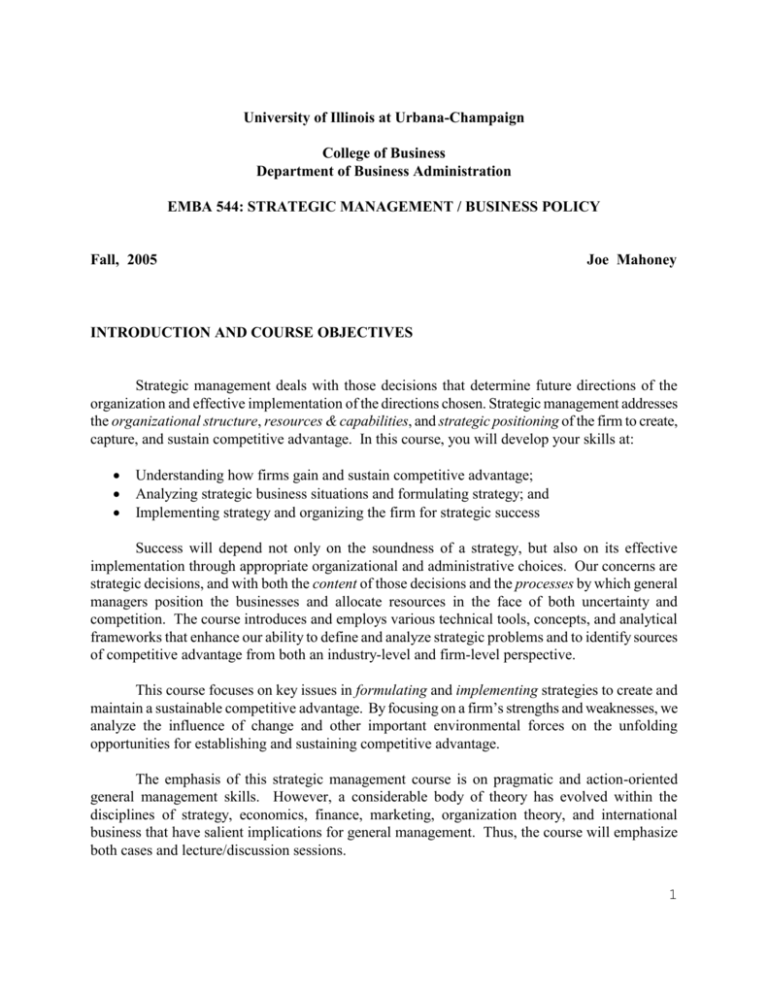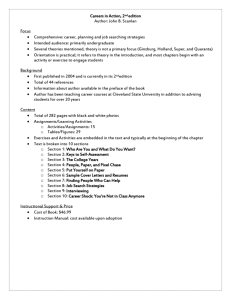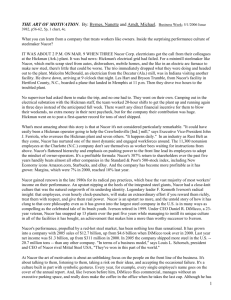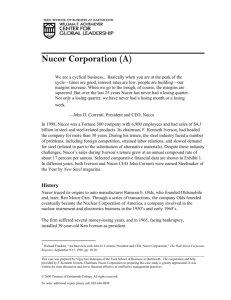MS Word - College of Business - University of Illinois at Urbana
advertisement

University of Illinois at Urbana-Champaign College of Business Department of Business Administration EMBA 544: STRATEGIC MANAGEMENT / BUSINESS POLICY Fall, 2005 Joe Mahoney INTRODUCTION AND COURSE OBJECTIVES Strategic management deals with those decisions that determine future directions of the organization and effective implementation of the directions chosen. Strategic management addresses the organizational structure, resources & capabilities, and strategic positioning of the firm to create, capture, and sustain competitive advantage. In this course, you will develop your skills at: Understanding how firms gain and sustain competitive advantage; Analyzing strategic business situations and formulating strategy; and Implementing strategy and organizing the firm for strategic success Success will depend not only on the soundness of a strategy, but also on its effective implementation through appropriate organizational and administrative choices. Our concerns are strategic decisions, and with both the content of those decisions and the processes by which general managers position the businesses and allocate resources in the face of both uncertainty and competition. The course introduces and employs various technical tools, concepts, and analytical frameworks that enhance our ability to define and analyze strategic problems and to identify sources of competitive advantage from both an industry-level and firm-level perspective. This course focuses on key issues in formulating and implementing strategies to create and maintain a sustainable competitive advantage. By focusing on a firm’s strengths and weaknesses, we analyze the influence of change and other important environmental forces on the unfolding opportunities for establishing and sustaining competitive advantage. The emphasis of this strategic management course is on pragmatic and action-oriented general management skills. However, a considerable body of theory has evolved within the disciplines of strategy, economics, finance, marketing, organization theory, and international business that have salient implications for general management. Thus, the course will emphasize both cases and lecture/discussion sessions. 1 Strategic management, as much as any course, deals with the world of experience. The world of experience is not a world of certainty. Therefore, within the classroom, reasonable people (with different business and non-business experiences) will view management differently. These different views have the potential to provide a healthy tension. Management, whether discussed in the classroom or discussed within a firm involves "making sense together." The very idea of making sense involves a creative process and is personal (and subjective). Conjectures and (subjective) knowledge based on your personal experiences are highly valued within the conversation of this class. Creativity will be rewarded in your participation grade, your individual papers, and your team projects. This course also rewards the hard worker who has the ability to listen and think critically. The course will provide a great deal of material and will require that you process the material. The final in-class (closed-book) exam will test your ability to understand the material in the textbooks, readings, and class notes. Please note that the evaluation of your case analyses and the exams measure different skills. THE RELATIONSHIP OF STRATEGIC MANAGEMENT TO OTHER BUSINESS COURSES Up until this time, most of your business education at UIUC has emphasized a specialized, functional perspective of business situations. In accounting, you have concentrated on how to identify and produce the information necessary to manage and guide organizations effectively. In finance, you have been concerned with understanding how capital markets work and, in turn, affect the financing of a company’s on-going operations. In marketing, the focus has been on how to analyze, shape, and address the needs of consumers as well as how to manage a company’s marketing efforts. In operations management, the focus is on how to organize the production activities of a firm so it is able to produce quality goods and services at an attractive price. Finally, courses on the management of human resources have been concerned with the effective development and management of a company’s human assets. All of these functional disciplines play a critical role in the success of a company, but how do they fit together? In this course, we integrate these views together by taking a unique perspective, that of the situational problems of the general manager. The general manager's job is to diagnose what is critical in complex business situations and to find realistic business solutions to strategic and organizational problems. To solve such problems, the general manager must be capable of both understanding and applying the knowledge from each of the organization’s functional areas to provide a "total business" (systems) perspective on issues pertaining to strategic management. In addition, the general manager must be able to analyze competitive situations within industries in order to understand the sources of the firm’s competitive advantage. We see strategy as enabled and constrained by the underlying economic and political conditions that prevail in an industry or country, as well as by the resources available to management. In today’s business environment, everyone (not just the CEO of the company) must be capable of thinking like a general manager. 2 TECHNIQUES FOR LEARNING STRATEGIC MANAGEMENT To accomplish our objectives, we will use a variety of learning techniques: lectures, outside of class assignments, readings, written reports, presentations, and most importantly, class discussion of case studies. Case Analysis Strategic thinking and analysis are best learned through practice. The cases we will study are about real world business situations. A case is designed to provide you with data on real-life managerial problems, and case analysis is useful as a simulation of actual managerial activity. The cases provide an opportunity to both apply the concepts we discuss in class as well as to further develop our ability to think about business strategy. How much you get out of the case depends on your preparation and active participation. Each of us must be fully prepared for each class, and there will be assignments throughout the term to help focus our preparation. Everyone is expected to participate effectively in each class to comment, question, and analyze. Objectives of Case Analysis: [1] Increase your understanding of what managers should and should not do in guiding business to success. [2] Build your skills in conducting strategic analysis and gain in-depth experience in a variety of industries, competitive situations, and company circumstances. [3] Get valuable practice in diagnosing strategic issues, evaluating strategic alternatives, and formulating workable plans of action. [4] Enhance your sense of business judgment. Team Work Discussing cases and preparing analyses outside of class helps to deepen your knowledge about strategy. Thus, Team-level work will be essential for weekly case preparation as well as the major team project. Developing effective team-level skills is a critical part of the learning process. Course Organization Your class assignments are shown in the syllabus attached, and while subject to change, this syllabus should guide your work planning for the course. There will be no announcements in class concerning assignments, except those infrequent ones that may alter those in the attached syllabus. 3 Course Policies Course Etiquette: 1. Be on time. Since participation is an important part of the course, points are deducted if you are late --- simply put, a grading system that does not enforce core values is poor management. Points are also deducted if you are not prepared for the case discussion. In terms of absences, course policies are more accommodating than for any other UIUC program because some seriously diligent folks will have other obligations. Therefore, you can take two absences (e.g., one week-end) no questions asked; beyond those two absences, substantive point deductions are then made. 2. Do not disrupt the class with side conversations during class. 3. Be respectful of others in the class. Listen, give attention, let other people talk, don’t shout, and above all else do not sneer at others. 4. All cell phones and pagers should be turned off during class. Please do not leave and reenter the class. 5. Using laptops in the classroom is a privilege, not a right. Laptops are to be used for class activities only. If you are seen net surfing or e-mailing during a class session you lose laptop privileges for the remainder of the course. BIBLIOGRAPHY OF TEXT AND CASES Textbooks: Grant, Robert M. (2005). Contemporary Strategy Analysis: Concepts, Techniques, and Applications. Malden, MA: Blackwell. Mahoney, Joseph T. (2005). Economic Foundations of Strategy. Thousand Oaks, CA: Sage Publications. Reading: Porter, Michael (1996). “What is Strategy?” Harvard Business Review, (NovemberDecember): 61-78. (T.I.S. bookstore, BA 389 Case Readings packet). Cases: Harvard Business Cases (T.I.S. bookstore, MSBA 444 Case Readings packet). 4 Cases for EMBA 444: 1. Wal-Mart Stores, Inc. 9-794-024 Retailing Industry 2. RTE Cereal Industry 9-795-191 RTE Cereal Industry 3. Coke v. Pepsi in the 1990s 9-794-055 Soft Drink Industry 4. Leadership Online: Barnes & Noble Vs. Amazon.com 9-798-063 Online Business Model 5. Andersen v. Andersen 9-800-064 Consulting Industry 6. Viacom 9-396-250 Entertainment Industry 7. Nucor at a Crossroads 9-793-039 Steel Industry COURSE REQUIREMENTS AND GRADING (1) Individual case assignments (5 cases; 20 points each) •Note: You do not have a written assignment for the case you present (2) Team Case Assignment for Nucor (3) Participation (4) Team Presentation (5) Final Exam 100 points 50 points 50 points 50 points 150 points -------------400 points Final Grading Scale: Course Points 390 - 400 370 - 389 360 - 369 350 - 359 330 - 349 320 - 329 300 - 319 290 - 299 280 - 289 250 - 279 Below 250 Grade A+ A AB+ B BC+ C CD F Honor Points 4.00 4.00 3.67 3.33 3.00 2.67 2.33 2.00 1.67 1.00 0.00 5 Details Concerning Assignments (1) Individual case write-ups for five cases (20 points each) 100 points You are expected to do all assignments based on the schedule shown on the attached syllabus. Assignments are due before class begins on the day of the case (so bring an extra copy for yourself). One purpose of the assignment is to enhance class discussion. There is no credit provided for late assignments. I expect each person to prepare a 1-page analysis (typed and single spaced using 12point font). Outside research for the case analysis (unless you are the presenting team) is highly discouraged. Analyze the case, as provided. Criteria for the five 1-page individual case write-ups: Problem statement: Define the scope of the problem in the first paragraph of your paper. Conclude the first paragraph with the question. Explain why the question is important. (5 points) Analysis: Analysis remains focused on addressing the question raised. Indicate the factors that are important for answering your question and indicate the interrelationships between factors. Use data! (10 points) Recommendations: Suggested recommendations should follow logically from analysis (in light of the data). Be sure to discuss implementation issues. (5 points) (2) Team Case Assignment for Nucor 50 points The Nucor assignment asks you to provide: 1. A cash flow analysis (where a template will be provided); 2. Scenario analysis (i.e., changes within the model); and 3. Strategic analysis (i.e., considerations outside the model) (3) Participation (15 points) (15 points) (20 points) 50 points Active participation in the class is an essential part of the learning experience. We will be using cases and you must be prepared to discuss these cases. Meaningful participation means making a contribution to our discussion, not merely talking, and it does not mean repeating case facts or simply agreeing with what others have already said. Our interest is not "right" or "wrong,” it is whether you have made a contribution to the development of the issues under study by the class, and whether you have moved the class forward. One clear way of making a contribution is to disagree with the comments of your classmates where needed; it is not the instructor's duty alone to decide 6 whether a remark is of value. Failure to participate and disagree where needed penalizes you and the class in these ways: · · · · You lose incentive to prepare the case properly You lose the chance to develop communication skills You deprive all of us of your insights into the case Your ideas go unevaluated by others Please do not confuse attendance with participation. While on-time attendance is important, active participation in the class discussion is evaluated separately (25 points for perfect attendance, and the remaining 25 points are earned by discussing the cases). (4) Team Presentation for Primary Case. 50 points You and your team will have primary responsibility for leading a discussion of the update of the case (45 minutes). It is your responsibility to update the case to the present. Each member of the team should lead a discussion and provide updated material. It is imperative that team members coordinate their work. Your grade on the team presentation will be a team grade. If there are any problems with non-contributing team members, please let me know. The objectives of these assignments are to enhance your ability to: - Develop a clear and direct presentation - Utilize visual aids to support the presentation - Think on your feet - Evaluate the adequacy of an argument, position or plan - Listen critically and pose worthwhile questions that facilitate constructive team problemsolving; and - Give and receive criticism in a socially acceptable manner The oral presentation will be delivered on the same day that the written case is due. The use of visual aids (overheads, charts, graphs) is recommended to enhance the clarity of your presentation. All members of a team are expected to participate equally in the presentation. Presenters should avoid merely reading out presentation material. The team will be evaluated on the cohesiveness and logic of the arguments presented. Presentations are professional (this requirement means a dress shirt when presenting). A copy of all transparencies (Power Points) and exhibits must be provided to the instructor two days before the presentation. The quality of the exhibits will be considered in the evaluation of the team's presentation. 7 Presentation Evaluation: - Substance of Presentation - Clarity: Audibility, wording, flow of ideas - Persuasiveness: Credibility, eye contact - Use of visual aids: Clarity and readability - Information clearly organized - Management of time - Equal division of presentation material - Ability to answer questions, think on feet (15 points) (05 points) (05 points) (05 points) (05 points) (05 points) (05 points) (05 points) Cases for EMBA 444: 1. Wal-Mart Stores, Inc. Instructor 2. RTE Cereal Industry Team B • Raj Gelaboina, Steve Hansen, Scott Jackson, Bob Sarkar, Rita Schulte 3. Coke v. Pepsi in the 1990s Team G • Brenda Barber, Craig Darrah, Mica Lesser, Karla Oselka, Dan Ulrich 4. Leadership Online: Barnes & Noble vs. Amazon.com Team D • Sharri Hall, Bob Laskey, Alan Levy, Dave O’Brochta, Dave Reitzel 5. Andersen v. Andersen Team A • Jeff Bruce, Jason Dederich, Jure Kutlesa, Atul Mangla, Mike Parkinson, Andrea Stetz 6. Viacom Team F • Steve DeMilliano, Edgar Jimenez, Brian McHugh, Holly Olson, Raman Singh, Nancy Stahulak 7. Nucor at a Crossroads Team C • Don Adams, Amitava Banerjee, Andrew Brannen, Pat Kennedy, Ron Snipes --------------------------------------------------------------------------------------------------(5) In-class exam 150 points The exam will be a closed book and closed-notes exam. 8 CLASS SESSIONS AND ASSIGNMENTS SESSION #1 Friday, September 2 (Time Period #3) “No amount of sophistication is going to allay the fact that all your knowledge is about the past and all your decisions are about the future.” Ian E. Wilson, former chairperson, General Electric Assignment: Read: Grant Chapter 1 “The Concept of Strategy” Learning Objectives: 1. 2. 3. 4. 5. Introduction to the strategic management course. What is strategy and its role in achieving the objectives of the firm? What is the role of the general manager? Why are cross-functional teams increasingly important? What is sustainable competitive advantage and how can the strategic management process enable the firm’s managers to achieve such an advantage? Handouts: SESSION #2 #1 #2 Websites of Companies Management Skills Friday, September 2 (Time Period #4) “Connect, always connect.” Goethe Assignment: Read: Grant Chapter 2 “Goals, Values, and Performance” Learning Objectives: 1. 2. 3. What are the elements in “defining the business?” What are the hierarchical definitions of strategy? What is “strategic coherence?” Why is it important? Handouts: #3 #4 Levels of Strategy Strategic coherence 9 SESSION #3 Assignment: Saturday, September 3 (Time Period #2) Read: Porter (1996) (in packet) “What is Strategy?” Learning Objectives: 1. 2. 3. 4. According to Porter (1996), what is strategy? What are the conceptual approaches to defining performance? What are the measures of performance? What are some sources of above-average performance? Handouts: #5 SESSION #4 Sustainable Competitive Advantage and the Measurement of Firm Performance Saturday, September 3 (Time Period #3) “With the possible exception of Henry Ford, Sam Walton is the entrepreneur of the century.” — Tom Peters, co-author of In Search of Excellence Assignments: Read: Case #1 Wal-Mart Stores Inc. Write: One-page write-up Learning Objectives: 1. 2. 3. 4. 5. Handouts: What is Wal-Mart's "Strategy?" How do the different "functional" strategies (operational, marketing, financial, human resource) "fit" together in a unique manner? Historically, what have been the sources of Wal-Mart's competitive advantage in discount retailing? Given recent changes in the competitive environment, what can or should Wal-Mart do to maintain its competitive advantage? In other words, how sustainable is WalMart’s competitive advantage? Are Supercenters the answer to the threats that Wal-Mart faces? None 10 SESSION #5 Saturday, September 3 (Time period #4) Assignment: Read: Grant Chapter 3 “Analyzing the Industry Environment” Learning Objectives: 1. 2. What is the Structure-Conduct-Performance Model? How does industry (5-Forces) analysis help you to identify profitability of an industry? Handouts: #6 A Note on Industry Analysis SESSION #6 Friday, September 16 (Time Period #3) Assignment: Review: Grant Chapter 3 “Analyzing the Industry Environment” Learning Objectives: 1. How does one test the S-C-P model? Handouts: #7 Empirical Testing of the Structure-Conduct-Performance Model #8 A Note on Strategic Group Analysis SESSION #7 Friday, September 16 (Time Period #4) Assignments: Read: Case #2 RTE Cereal Industry (Team B update) Write: One-page write-up Learning Objectives: 1. 2. 3. 4. What are the barriers to entry in this industry? How much power do suppliers and customers have? How do substitute products impact the industry? How do the structural factors above affect rivalry? 11 SESSION #8 “Dare to be naive.” Assignments: Saturday, September 17 (Time Period #3) R. Buckminster Fuller Read: Write: Case #3 Cola Wars Continue (Team G) One-page write-up Learning Objectives: 1. What are the barriers to entry in this industry? 2. How much power do suppliers and customers have? 3. How do substitute products impact the industry? 4. How do the structural factors above affect rivalry? ---------------------------------------------------------------------------------------------------------------------SESSION #9 Saturday, September 17 (Time Period #4) “I was not successful as a baseball player, as it was a game of skill.” Assignments: Casey Stengel Read: Grant Chapter 5 “Analyzing Resource and Capabilities” Learning Objectives: 1. 2. 3. 4. 5. What are the drives of sustainable competitive advantage? How do firms create capabilities? What are four criteria used to determine if a firm’s resources are core competencies? How is value-chain analysis related to “core competencies?” How can a firm prevent core competencies from becoming core rigidities? Handouts: #9 #10 Resources and Capabilities/ Value chain analysis Learning Curves SESSION #10 Friday, September 30 (Time Period #3) “Plans are nothing, planning is everything.” Dwight D. Eisenhower Assignment: Read: Case #4 Barnes & Noble vs. Amazon.com (Team D update) Write: One-page write-up 12 SESSION #11 Friday, September 30 (Time Period #4) Assignment: Read: Case #5 Write: One-page write-up SESSION #12 Andersen vs. Andersen (Team A Update) Saturday, October 1 (Time Period #2) “He who hesitates is sometimes saved.” James Thurber Read: Grant Chapter 4 “Intra-industry Analysis” Chapter 7 “The Nature and Sources of Competitive Advantage” Assignments: Learning Objectives: 1. 2. 3. 4. What is the value of strategic flexibility? Under what conditions are strategic commitments more likely to lead to sustainable competitive advantage? How can game theory tools and cash-flow analyses be used together? When are first-mover advantage and second-mover advantage applicable? Handouts: SESSION #13 #11 #12 #13 #14 #15 Basic Financial Model of the Firm Valuing Strategic Flexibility Using Strategic Commitment to Influence Competitor Response Using Strategic Commitment to Influence Cooperative Response Strategic Management Notes Friday, October 14 (Time Period #3) “ ... good management rests on a reconciliation of centralization and decentralization.” Alfred P. Sloan Assignment: Read: Case #6 Viacom (Team F Update) Write: One-page write-up 13 SESSION #14 Friday, October 14 (Time Period #4) “ ... a manager’s authority comes from the employees. Distance yourself from your people and you distance yourself from your base of authority.” Ken Iverson in Plain Talk (1998). “The leader must know, must know that he knows, and must be able to make it abundantly clear to those around him that he knows.” Clarence B. Randall, chairperson, Inland Steel Assignments: Read: Case #7 Nucor (Team C Update) Write: Team Assignment on Strategic Analysis and Cashflow Analysis Learning Objectives: 1. What potential first-mover advantages and disadvantages will Nucor confront if they decide to adopt the CSP technology? 2. Should Nucor adopt the "Thin-Strip" casting technology? Are there any potential benefits in waiting? SESSIONS 15 and 16 Saturday, October 15 (Time Periods #3 and #4) “These then are my last words to you. Be not afraid of life. Believe that life is worth living and your belief will help create that fact.” William James 3-hour (in-class, closed book) exam. 14












